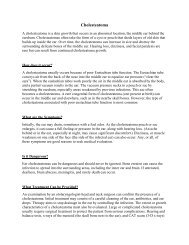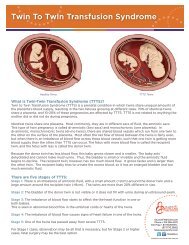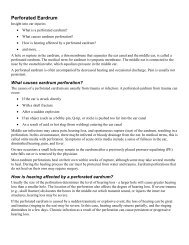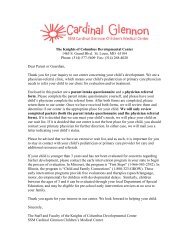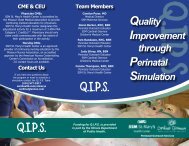perinatal-times_2013-03_print_and_read - SSM Cardinal Glennon ...
perinatal-times_2013-03_print_and_read - SSM Cardinal Glennon ...
perinatal-times_2013-03_print_and_read - SSM Cardinal Glennon ...
You also want an ePaper? Increase the reach of your titles
YUMPU automatically turns print PDFs into web optimized ePapers that Google loves.
THE PERINATAL OUTREACH PROGRAMThe Perinatal Outreach Program is a collaborative effort between<strong>SSM</strong> Maternity Care at St. Mary’s Health Center, <strong>SSM</strong> <strong>Cardinal</strong> <strong>Glennon</strong>Children’s Medical Center <strong>and</strong> Saint Louis University School of Medicine.It is designed to improve outcomes for mothers <strong>and</strong> babies througheducational programs <strong>and</strong> quality improvement activities for regional<strong>perinatal</strong> care providers in eastern Missouri <strong>and</strong> Southern Illinois.The Perinatal Outreach Program is the designated AdministrativePerinatal Center for Southern Illinois.VOL. 27 NO. 1 | MARCH <strong>2013</strong>PERINATAL TIMES EDITORIAL BOARDConnie Thompson, RNC, BSN, Editor<strong>SSM</strong> <strong>Cardinal</strong> <strong>Glennon</strong> Children’s Medical CenterAyoob Ali, MD, MPHGlenn Barber, RNC, BSNRobyn Gude, RN, MSNMary Hope, RN, BSNWilliam Keenan, MDPatricia Oberkirsch<strong>SSM</strong> St. Mary’s Health CenterErol Amon, MD, JDKathy Canchola, RN, BSNGilad A. Gross, MDKatie Kulaitis, RN, BSNThomas Myles, MDPam R<strong>and</strong>azzo, RNC, BSNSharon Rector, RNC, MSNJudy Wilson-GriffinFUNDINGFinancial support for the The Perinatal Times is provided by<strong>SSM</strong> Health Care - St. Louis <strong>and</strong> the Illinois Department of Public Health.IN THIS ISSUE:1346GLUCOSE CONTROL DURINGLABOR MADE EASY it’s not asformidable as it soundsFORMULARY FACTS: LEVEMIRDURING PREGNANCY a stepforward in managing diabetesINFANT OF A DIABETIC MOTHERa unique set of challenges forthe clinical practitionerMONITOR CORNER cervicalripening & labor induction dueto complex historyLETTERSThe Perinatal Times welcomes comments on any of its articles <strong>and</strong> willconsider such letters for publication. Suggestions for future topics ofinterest or announcements are encouraged.Please send correspondence to:The Perinatal TimesConnie Thompson, Editor<strong>SSM</strong> St. Mary’s Health Center6420 Clayton Road, Richmond Heights, MO 63317connie_thompson@ssmhc.com
GLUCOSE CONTROL DURING LABOR MADE EASYBY DOROTHEA MOSTELLO, MDControlling glucose in labor for women with diabetes is not asformidable as it sounds. Underst<strong>and</strong>ing three basic principlesthat underlie this practical approach to glucose management isthe key to success:1. Assure adequate hydration <strong>and</strong> nutrition2. Avoid high glucose values <strong>and</strong> large boluses of dextrose3. Frequently monitor <strong>and</strong> adjust fluids to achieve the goalof keeping the maternal glucose level between 70 <strong>and</strong>110 mg/dl.LABOR IS WORKLabor is work - work that is performedmost efficiently with adequatehydration <strong>and</strong> nutrition. Totalfluids in the range of 200-250 cc/hr result in faster labors. Thecells that do the work needfuel. Most women require6-10 grams per hour of glucoseto avoid starvation ketosis,when catabolism of fat <strong>and</strong>muscle kicks in. No calculator isrequired: “D5” means 5 gramsof dextrose per 100 cc. It is easyto do the math from there. Avoidthe temptation to use only fluidswithout dextrose. The cells of womenwith diabetes need as much fuel as anyoneelse. Monitor for ketones in the urine to see ifthe laboring woman is getting enough nutrition for hertask. If she is, the ketones should be negative.MORE THAN DEXTROSEGiving dextrose is not enough. Glucose needs to get into thematernal cells to meet her needs. This job is accomplished byinsulin, either endogenous or prescribed, <strong>and</strong> insulin keepsthe circulating glucose levels appropriate. High circulatinglevels of glucose during labor easily cross the placenta <strong>and</strong> insome ways can undo months of even excellent control. Thehigh levels can ramp up the baby’s insulin production <strong>and</strong> leadto hypoglycemia in the nursery. In addition, a large supplyof glucose, either from high circulating levels or from a largebolus, can be detrimental to the fetus in <strong>times</strong> of distressby leading to build up of byproducts of anaerobic glucosemetabolism when oxygen is limited. Keep the maternalglucose in the target range.Monitor glucose about every 2 to 3 hours during latentphase or cervical ripening; increase to hourly in activelabor. An intravenous insulin infusion is the most commonway to control glucose levels in labor. The correct rate ofmaintenance insulin infusion is the rate that keeps the glucoselevel in the same range from hour to hour. The correctincremental increase will allow an elevated glucose levelto return to the target range within an hour. Fortunately,most women with diabetes in pregnancy can be maintainedin the target range with one unit per hour, withincremental increases of one unit per hourfor every 30 mg/dl above the targetrange. Some women with highinsulin resistance will need 2 unitsper hour for maintenance <strong>and</strong> atighter incremental increase.Very insulin-sensitive women(especially with type 1 diabetes)may only need 0.5 units/hr <strong>and</strong>a looser scale for increases. Ifthose rates <strong>and</strong> incrementalincreases don’t quite do it,adjust the scales empiricallyto achieve glucose levels in thetarget range. For St. Louis area<strong>SSM</strong> hospitals, st<strong>and</strong>ard ordersets are in the electronic record,which make ordering <strong>and</strong> altering theseinfusions easier. These order sets haverecently been updated <strong>and</strong> will soon be released.THERE ARE ALWAYS CAVEATS1. An insulin infusion is not always required. Many dietcontrolledgestational diabetics can maintain glucosevalues in labor on their own, but this cannot beassumed, so monitoring these patients is just as critical.Repeated subcutaneous injections of rapid-acting insulinmay be an alternative to an intravenous infusion, butdoses are difficult to guesstimate <strong>and</strong> absorption may bevariable when sites of injection are exercised. Womenusing an insulin pump who present in active labor, maykeep their glucoses stable <strong>and</strong> in the acceptable rangethroughout the entire labor using their pump basalrates. Similarly, women taking insulin who present inactive labor may deliver before their insulin on board(Continued on page 2)THE PERINATAL TIMES | 1
GLUCOSE CONTROL DURING LABOR - MADE EASY(Continued from page 1)dissipates <strong>and</strong> not require any more insulin duringlabor. Some may actually require extra glucose iftheir insulin peaks while they are NPO during activelabor.2. With long inductions <strong>and</strong> cervical ripening, mealcoverage becomes an issue. Adjustments inan insulin infusion for the duration of the meal<strong>and</strong> the following hour can cover a meal, as willsubcutaneous injections. Most clear liquids havecalories, as well, that are quickly absorbed <strong>and</strong> causea spike in the glucose level if not covered. Thinkingahead <strong>and</strong> common sense are the best allies in theseatypical situations. ●REFERENCESReferences available on request.ABOUT THE AUTHORDr. Dorothea Mostello is a Saint Louis University Professor of Obstetrics <strong>and</strong>Gynecology, Department of Obstetrics, Gynecology <strong>and</strong> Women’s Health; aMaternal-Fetal Medicine specialist in the Maternal-Fetal Medicine Division <strong>and</strong>Director of the Diabetes-in-Pregnancy Program at <strong>SSM</strong> St. Mary’s Health Center,St. Louis, MO.FORMULARY FACTSBY AREZO NOORMOHAMMADI, PHARM.D.AND ALICIA B. FORINASH, PHARM.D., BCPS, BCACPNPH insulin, with or without rapid-acting insulin, had beenconsidered st<strong>and</strong>ard of care in pregnancy when patientsrequired insulin. Two basal insulins (glargine, Lantus® <strong>and</strong>detemir, Levemir®) are widely used in non-pregnant patientsas an alternative for NPH. Studies have shown that detemirdoes not differ significantly from regular human insulin withregard to activation of insulin-like growth factor-I (IGF-I).1Stimulation of IGF-1 receptors increases the risk for excessivefetal growth. However, glargine has higher affinity to bind toIGF-I receptors than detemir thus decreasing the potential forglargine’s use in pregnancy. (1,2)Detemir is a peakless, long-acting insulin with a durationof 24 hours, administered once or twice daily. Because ofits peakless effects, fasting blood sugar (FBS) should be theprimary target for adjustments. Detemir should not be mixedwith other insulin <strong>and</strong> is stable at room temperature for 42days after opening. (3) In contrast, NPH has a peak that canvary but occurs approximately around 4-12 hours <strong>and</strong> isgenerally split into two doses per day. (4)Until recently, safety data was lacking for detemir duringpregnancy; however, a recent r<strong>and</strong>omized, open-label,controlled, multicenter trial published in October 2012demonstrated similar effects of detemir <strong>and</strong> NPH duringpregnancy. (5) This trial evaluated the efficacy <strong>and</strong> safety ofinsulin detemir compared to NPH in 310 pregnant women withType 1 diabetes.Mathiesen <strong>and</strong> colleagues r<strong>and</strong>omized patients to eitherdetemir or NPH plus insulin aspart with meals. Patients wereincluded if they had a singleton gestation between 8 <strong>and</strong> 12weeks or if they intended to become pregnant, were on insulinfor at least 12 months prior to enrollment, <strong>and</strong> had A1c
LEVEMIR IN PREGNANCYneonatal outcomes were not presented in this manuscript butshould be published later.The study was open-labeled, therefore it could have beeninfluenced by possible confounding factors. It is alsoimportant to note that the study was performed includingpatients with Type 1 diabetes, limiting its external validity inextrapolating to patients with gestational diabetes or type2. However, it is likely that similar results would be seen inpatients with gestational diabetes.Unfortunately, initial dosing strategies for detemir have notbeen published. However, in non-pregnant patients, detemircan be initiated at bedtime doses of 0.1-0.2 units/kg/day.When used in non-pregnant patients, the total daily insulindose is divided into 50% detemir <strong>and</strong> 50% rapid-acting insulin.The rapid-acting insulin is further divided to give 1/3 witheach meal.Detemir can now be considered an effective option formanagement of diabetes in pregnancy. Based on thesefindings, the FDA has changed detemir to pregnancy categoryB. (1) This is a major step forward in the management ofdiabetes in pregnancy. ●EFFICACY RESULTSREFERENCES1. Porcellati F, Rosetti P, C<strong>and</strong>eloro P, et al. Short-term effects of the long actinginsulin analog detemir <strong>and</strong> human insulin on plasma levels of insulin-likegrowth factor-I (IGF-I) <strong>and</strong> its binding proteins in humans. J ClinEndocrinMetab2009;94:3017-24.2. Varewijik AJ, Goudzwaard JA, Brugts MP, et al. Insulin glargine is more potentin activating the human IGF-I receptor than human insulin <strong>and</strong> insulin demetir.Growth Horm IFG Res 2010;20:429-41.3. Levemir [package insert]. Princeton, NJ: Novo Nordisk Inc; May 2012.4. Insulin pharmacokinetics. Facts <strong>and</strong> Comparison St. Louis, MO. Website http://online.facts<strong>and</strong>comparisons.com/MonoDisp.aspx?monoID=f<strong>and</strong>c-hcp11093&quick=8274%7c24&search=8274%7c24&isstemmed=True&fromTop=true#InsulinPharmacokinetics. Accessed January 15, <strong>2013</strong>.5. Mathiesen ER, Hod M, Ivanisevic M et al. Maternal efficacy <strong>and</strong> safety outcomesin a r<strong>and</strong>omized, controlled trial comparing insulin detemir with NPH insulin in310 pregnant women with Type 1 diabetes. Diabetes Care 2012;35:2012-17.ABOUT THE AUTHORSAlicia B. Forinash, Pharm.D., BCPS, BCACP is an Associate Professor of PharmacyPractice at the Saint Louis College of Pharmacy <strong>and</strong> an OB-Gyn/Maternal-Fetal ClinicalPharmacy Specialist at <strong>SSM</strong> St. Mary’s Health Center, St. Louis, MO.Arezo Noormohammadi, Pharm.D. is a PGY2 Ambulatory Care Resident at the SaintLouis College of Pharmacy at <strong>SSM</strong> St. Mary’s Health Center.THE PERINATAL TIMES | 3
INFANT OF A DIABETIC MOTHERBY JEFFREY COOPER, MDIn our society, where diabetes <strong>and</strong> obesity problems areincreasing (no pun intended), we are seeing more <strong>and</strong> moreinfants born to diabetic mothers. This presents a unique setof challenges to the practitioner caring for these infants afterbirth. Improved maternal care during pregnancy may reducesome neonatal morbidities (hypoglycemia, polycythemia,hyperviscosity, intrauterine growth restriction), as well as fetalmacrosomia with consequent birth trauma. The following isa review of the care of the infant born to a diabetic mother(IDM).Macrosomia is the hallmark of diabetic pregnancy. Despitecontinued advances to normalize glucose concentrationsin mothers, fetal overgrowth occurs more than in normalpregnancies. As glucose passes across the placenta viafacilitated diffusion, maternal insulin does not cross. Thisrequires the infant to produce its own increased insulinsupply to utilize the glucose. This increase in insulin primarilystimulates adipose tissue. Brain <strong>and</strong> head growth tend to bespared, while shoulder size increases due to intrascapular fatdevelopment. IDMs have 50% more total body fat comparedwith infants of mothers with normal metabolism making themat increased risk for shoulder dystocia. They also have anincreased abdominal girth due to hepatomegaly from insulindrivingglycogen storage.Hypoglycemia occurs shortly after delivery, as the infant hasbeen receiving a steady state of glucose from the placenta.Once the cord is clamped, the infant transitions to using itsown glucose stored as glycogen or relying on glucose from oralintake. The insulin levels do not drop off immediately <strong>and</strong> theinfant requires sufficient glucose to prevent hypoglycemia.The goal of management should be to deliver enough glucoseto achieve normoglycemia while avoiding stimulation of thepancreas to produce more insulin.Hypocalcemia has also been observed, <strong>and</strong> infants may beasymptomatic, jittery or rarely, develop seizures. Recentdata may point to maternal diabetes causing urinary loss ofmagnesium, which blunts parathyroid hormone secretioncausing neonatal hypocalcemia.Respiratory distress syndrome (RDS) is another potentialproblem of IDMs. Fetal hyperinsulinemia impedes production<strong>and</strong> release of surfactant into the lungs. Previous inaccurateestimates of gestational age due to macrosomia resulted inpreterm delivery with associated RDS.IDMs are at increased risk for polycythemia <strong>and</strong> possiblehyperviscosity syndrome in the neonatal period. Erythroidprecursors tend to be sensitive to insulin which causes anincreased number of RBCs in the circulation. Hyperviscosityresulting from polycythemia may cause renal vein thrombosis,stroke, <strong>and</strong> other organ damage.Due to high red cell mass, hyperbilirubinemia is commonin IDMs. In addition, macrosomic infants tend to bebruised at delivery, <strong>and</strong> resorption of that blood can lead tohyperbilirubinemia.These infants are also at risk for cardiomyopathy, includingthickened interventricular septum <strong>and</strong> left or right ventricularwall. Rarely, they present with aortic outflow obstructionsufficient enough to cause left ventricular failure. Mostabnormalities resolve within the first year.Finally, IDMs are at an increased risk for congenitalmalformations, such as cardiac anomalies, spinal agenesiscaudalregression syndrome, neural tube defects, <strong>and</strong>gastrointestinal <strong>and</strong> urinary tract anomalies. Neonatal smallleft colon is a transient finding in IDMs. They present withintestinal obstruction with a Hirschsprung-like radiograph;however, they have normal bowel innervation. Eventually,they develop normal function.There should be a clear <strong>and</strong> organized plan for delivery.St<strong>and</strong>ard NRP protocol should be initiated at every delivery.Practitioners should be prepared for a possible shoulderdystocia, with resultant birth injury, <strong>and</strong>/or asphyxia during avaginal delivery. Care should be taken to properly document1 <strong>and</strong> 5 minute APGAR scores <strong>and</strong> look at cord blood gases ifasphyxia is a concern. Injury to the brachial plexus could causeproblems from damage to the nerves of the arm to unilateraldiaphragmatic paralysis if the phrenic nerve is affected.Respiratory distress syndrome (RDS) is a common complicationso the practitioner should be <strong>read</strong>y to appropriately ventilatethe patient with CPAP, PPV, or intubation as needed.Signs <strong>and</strong> symptoms of hypoglycemia are nonspecific<strong>and</strong> infants may not be symptomatic. Symptoms includejitteriness, agitation, poor feeding, lethargy, seizures, apnea,grunting <strong>and</strong> sweating. A plasma glucose should be checked ininfants of diabetic mothers, even in the absence of symptoms.As the plasma glucose concentration drops rapidly afterdelivery, a glucose level should be obtained within 30 minutesafter birth. Guidelines for the close glucose monitoring <strong>and</strong>VOL. 27 NO. 1 | MARCH <strong>2013</strong>
management of theseinfants is as follows.(Remember that differentinstitutions may usedifferent guidelines forhypoglycemia.)If the level is > 45 mg/dL,oral feedings includingbreastfeeding shouldbe initiated within 3-4hours after delivery <strong>and</strong>may be beneficial tomaintain plasma glucoseconcentrations. Infantswho have borderlineglucose measurementswho are fed initially canprogress to requiringIV dextrose fluids.Glucose should berechecked prepr<strong>and</strong>ialfor a minimum of threefeedings.Screening <strong>and</strong> Management of Postnatal Glucose Homeostasisin Late Preterm <strong>and</strong> Term SGA, IDM/LGA Infants[(LPT) Infants 34 - 36 6/7 weeks <strong>and</strong> SGA (screen 0 - 24 hours); IDM <strong>and</strong> LGA >34 weeks (screen 0 - 12 hours)]Birth to 4 hours of ageINITIAL FEED WITHIN 1 hourScreen glucose 30 minutes after 1st feedInitial screen
MONITOR CORNERA CASE STUDY BY SHARON RECTOR, RNC-OB, C-EFM, MSNPRESENTATIONMs. L is a 20 year old, G3P1011 who presented to labor <strong>and</strong>delivery at 39 weeks <strong>and</strong> 3 days gestation with a spontaneouslyruptured bow of water, leaking green tinged amniotic fluid.Contractions on admission were mild <strong>and</strong> irregular occurringabout every 4-8 minutes. The fetal heart rate (FHR) baselinewas 140 bpm, with moderate variability, accelerationspresent <strong>and</strong> no decelerations (Category I). Her cervical examon admission was 2 cm, 50% effaced, -3 station, moderateconsistency <strong>and</strong> midposition with a cephalic presentation. Shewas admitted for expectant management of labor.BACKGROUNDMs. L was previously diagnosed with Bipolar II Disorder forwhich she had inconsistently taken her prescribed medications.She had a history of marijuana use with a positive urine drugscreen for marijuana during the pregnancy. She was alsodiagnosed with GBS bacteriuria in the first trimester.Her labor progressed spontaneously, <strong>and</strong> she received anepidural for pain management. She was given penicillin G 5million units IV followed by 2.5 million units IV every 4 hours.Approximately 1 hour after the epidural was placed strip #1was observed. Her cervical exam was 4 cm, 50% effaced, -2station, soft <strong>and</strong> midposition. Her blood pressure was 116/62to 120/70 <strong>and</strong> her heart rate was 62-68 bpm. Strip #2 occurredapproximately 15 minutes later. How would you interpretthese tracings? What interventions are indicated?INTERPRETATION AND DISCUSSIONIn strip #1 the baseline FHR is 145 bpm, the variability ismoderate, there are no accelerations <strong>and</strong> there are latedecelerations (Category II). A late deceleration is defined asa gradual (onset to nadir ≥ 30 seconds) decrease of the FHRfrom the baseline associated with a uterine contraction. Inmost cases the onset, nadir <strong>and</strong> recovery of the decelerationoccur after the beginning, peak <strong>and</strong> ending of the contraction,respectively. A late deceleration reflects disruption ofmaternal-fetal oxygen transfer from the environment tothe fetus resulting in transient fetal hypoxemia (Tucker,Miller & Miller, 2009). Interventions that will maximize fetaloxygenation are indicated <strong>and</strong> might include maternal positionchange, intravenous fluid administration, reduction of uterineactivity <strong>and</strong> oxygen administration. If the disruption of oxygentransfer is recurrent or sustained, it may progress to the stageof metabolic acidemia. The FHR during the decelerations isirregular, ranging from 80-90 bpm to 150-155 bpm, similarto the appearance of marked variability. Variability is aTRACING 1VOL. 27 NO. 1 | MARCH <strong>2013</strong>
characteristic of the FHR baseline, <strong>and</strong> as such it shouldnot be used to describe decelerations. According to Tucker,Miller & Miller (2009) the appearance of variability duringa deceleration has not been studied, <strong>and</strong> they discourageassigning undue significance to its occurrence. The moderatebaseline variability in this strip is highly predictive of theabsence of fetal metabolic acidemia.In strip #2 the baseline FHR is 155 bpm, the variability isminimal, there is one acceleration near the end of the strip<strong>and</strong> there are recurrent late decelerations (Category II). Somemight question the presence of late decelerations. Theyare subtle, the onset to nadir is about 25 seconds <strong>and</strong> thetiming appears to be delayed. This doesn’t completely fit thedefinition of a late deceleration, but these characteristicsdon’t completely fit any of the definitions of the four typesof decelerations. What do you do when a decelerationpattern doesn’t quite fit any of the definitions perfectly?Use your clinical judgment to most accurately label thedeceleration pattern, continue appropriate interventions <strong>and</strong>observe closely. It is imperative that this type of tracing bereviewed <strong>and</strong> discussed by all members of the care team.Communication among care providers is paramount especiallywhen there may be variation in the assessment, interpretation<strong>and</strong> plan of care.OUTCOMEInterventions in this situation included lateral positioning, IVfluid bolus <strong>and</strong> the administration of oxygen. Within about30 minutes the FHR returned to a baseline of 140 bpm,with moderate variability, occasional accelerations <strong>and</strong> noadditional late decelerations. The contractions became moreirregular with minimal change in her cervical exam.Oxytocin was administered <strong>and</strong> approximately 5 hours afterinitiation Ms. L was completely dilated. Shortly thereafter ababy boy was delivered vaginally with Apgar scores of 8 <strong>and</strong>9 at 1 <strong>and</strong> 5 minutes respectively. He weighed 4200 grams.Mom <strong>and</strong> baby had a normal postpartum course <strong>and</strong> weredischarged on day 2. ●REFERENCETucker, S.M., Miller, L.A., & Miller D.A. (2009). Fetal monitoring: A multidisciplinaryapproach (6th ed.). St. Louis, MO: Mosby Elsevier.ABOUT THE AUTHORSharon Rector is an Education Consultant specializing in <strong>perinatal</strong> nursing at <strong>SSM</strong>Health Care in St. Louis.TRACING 2THE PERINATAL TIMES | 7
NUTRITIONAL MANAGEMENT OF DIABETES & PREGNANCYBY RITA A. CHRIVIA, RD, CSP, LDWith the rising rates of obesity in the United States <strong>and</strong> theresulting rise in diabetes, chances are you are seeing moremothers <strong>and</strong> infants affected by diabetes in pregnancy.Reported rates of diabetes in pregnancy range from 2-10%of all pregnancies with 88% of those due to gestationaldiabetes, another 8% due to Type 2 <strong>and</strong> 4% due to Type1. (1) Poorly controlled diabetes beforeconception <strong>and</strong> during the first trimestercan cause major birth defects in5-10% of pregnancies <strong>and</strong>can result in spontaneousabortions in 15-20% ofpregnancies. Poorlycontrolled diabetesin the second <strong>and</strong>third trimestersof pregnancycan result inexcessively largebabies, posinga risk to bothmother <strong>and</strong> childduring labor<strong>and</strong> delivery.Gestationaldiabetes is a riskfactor for Type2 diabetes in themother; 5-10% ofwomen diagnosedwith gestational diabetesare found to have diabetesimmediately after the pregnancy.An estimated 15-50% will developdiabetes in the decades following theaffected pregnancy. (2)The good news is that intensive treatment of diabetes inpregnancy is associated with outcomes similar to thosein control populations. (3) For all types of diabetes inpregnancy, this involves medical nutrition therapy. Takinginto account the total calories per day, the number of mealsper day <strong>and</strong> the composition of those meals is important forreaching the goals of euglycemia, appropriate weight gain,<strong>and</strong> a healthy outcome for mother <strong>and</strong> child.Although the carbohydrate content of the diet is the firstpriority, total nutrient content <strong>and</strong> total calorie intake cannotbe ignored. A well balanced diet containing importantsources of vitamins <strong>and</strong> minerals, <strong>and</strong> promoting appropriateweight gain, is the goal for any pregnancy.Total calories per day should be based on the prepregnancyweight as a percent of ideal bodyweight. Women who are 80-120%of their ideal body weight arerecommended to have intakesof 30 calories per kg or 14calories per pound. Forobese women (120-150% of ideal bodyweight or with aBMI greater than27 kg/m2), 25calories per kgor 11 caloriesper pound is therecommendedintake. Womenwho are greaterthan 150% oftheir ideal weightare recommendedto have intakes of12-15 calories per kg<strong>and</strong> limit weight gain tono more than 8kg (17-18pounds). (3) While weightloss during pregnancy is notrecommended, a modest energy<strong>and</strong> carbohydrate restriction may beappropriate. (4) Avoidance of ketosis is importantto allow adequate provision of glucose to the fetal brain.The diet should be culturally appropriate, containing 1-1.2 gprotein per kg <strong>and</strong> at least 175 g carbohydrates per day. Totalcarbohydrates should be less than 45% of energy in womenwith gestational diabetes to prevent hyperglycemia. (5) Thecarbohydrates should be from complex sources with simplesugars <strong>and</strong> high glycemic index foods limited. Fiber intakeof 25-30 g per day is recommended as is a low saturated fatintake of less than 10% total calories. (6)VOL. 27 NO. 1 | MARCH <strong>2013</strong>
Normal hormonal changes in pregnancy lead todecreased insulin sensitivity <strong>and</strong> increased insulinresistance. This can result in transient hyperglycemiaafter meals. Hypoglycemia between meals <strong>and</strong> atnight can occur due to the continuous fetal draw ofglucose. Women with preexisting diabetes should beencouraged to maintain consistency in the timing oftheir meals <strong>and</strong> to include at least a bedtime snack toprevent hypoglycemia. The recommended distribution ofcarbohydrates to prevent hyperglycemia or hypoglycemiais 10-20% at breakfast, 20-30% at lunch, 30-40% atdinner with up to 30% for snacks. Insulin resistance ishighest in the morning due to increased cortisol levels.Adding protein to the morning meals <strong>and</strong> snacks mayhelp combat hunger. Smaller, more frequent mealsmay also help combat hunger, reduce the mealtimecarbohydrate load, reduce nausea <strong>and</strong> heartburn, <strong>and</strong>maintain a more stable postpr<strong>and</strong>ial blood glucose level.Unless contraindicated, the pregnant woman should beencouraged to participate in physical activity 30 minutesper day for a minimum of 3 <strong>times</strong> per week to improveglycemic control <strong>and</strong> general health. (5,6)Involving a registered dietitian who is familiar with thecomponents of medical nutrition therapy of diabetesduring pregnancy will allow for an individualized mealplan that reflects treatment goals <strong>and</strong> takes the woman’slifestyle into account. Barriers to compliance can also beaddressed <strong>and</strong> the meal plan modified as needed for thebest outcome for mother <strong>and</strong> infant.Breastfeeding is recommended for women withpreexisting diabetes <strong>and</strong> some data suggests it maydecrease the risk of Type 1 diabetes in the infant. Thewoman with Type 1 diabetes who breastfeeds mayexperience hypoglycemia <strong>and</strong> should be encouraged tohave a meal or snack available before or during feeds.Women diagnosed with gestational diabetes whobreastfeed appear to have a lesser chance of developingType 2 diabetes. Their children also have a decreasedrisk of childhood obesity <strong>and</strong> impaired glucose tolerance.(6) Postnatal follow up should include adapting the mealplan for breastfeeding <strong>and</strong> for achieving a more optimalweight if needed to minimize the risk of developinggestational diabetes in future pregnancies. ●REFERENCES1. Centers for Disease Control <strong>and</strong> Prevention. National Diabetes Fact Sheet:national estimates <strong>and</strong> general information on diabetes <strong>and</strong> prediabetes inthe United States,2011.Atlanta,GA:U.S. Department of Health <strong>and</strong> HumanServices, Centers for Disease control <strong>and</strong> Prevention,2011.2. Division of Reproductive Health. National Center for Chronic DiseasePrevention <strong>and</strong> Health Promotion. Pregnancy Complications,2012.http://www.cdc.gov/reproductivehealth/MaternalInfantHealth/PregComplications.htm3. Meltzer S. Management of Diabetes in Pregnancy: Challenges <strong>and</strong> trends.Canadian Journal of Diabetes. 2005:29(3):246-256.4. American Diabetes Association. Bantle JP, Wylie-Rosett J, Albright AL,et al. Nutrition recommendations <strong>and</strong> interventions for diabetes: aposition statement of the American Diabetes Association. Diabetes Care.2008:Jan;Suppl1:S61-78.5. American Dietetic Association(ADA). Gestational diabetes mellitus (GDM).Evidence based nutrition practice guideline. Chicago,IL;American DieteticAssociation (ADA);2008.6. Barbour LA, Friedman JE. Management of Diabetes in Pregnancy,2010.http://diabetesmanager.pbworks.com/w/page/17680258/Management%20of%20Diabetes%20in%20PregnancyABOUT THE AUTHORRita Chrivia is a Clinical Dietician at <strong>SSM</strong> <strong>Cardinal</strong> <strong>Glennon</strong> Children’s Medical Center inSt. Louis, MO.THE PERINATAL TIMES | 9
The Perinatal Times<strong>SSM</strong> <strong>Cardinal</strong> <strong>Glennon</strong>Children’s Medical Center1465 S. Gr<strong>and</strong> Blvd.St. Louis, MO 63104ADDRESS SERVICE REQUESTEDCONTINUING EDUCATION OPPORTUNITIESMany continuing education opportunities,including traditional lectures, h<strong>and</strong>s-on practiceas well as online presentations, are availablefor <strong>perinatal</strong> professionals in eastern Missouri<strong>and</strong> southern Illinois. These are offered through<strong>SSM</strong> St. Mary’s Health Center, <strong>SSM</strong> <strong>Cardinal</strong><strong>Glennon</strong> Children’s Medical Center, Saint LouisUniversity School of Medicine <strong>and</strong> the PerinatalOutreach Program. Most programs offer nursingcontact hours <strong>and</strong>/or CMEs.For course calendars or more specificinformation on programs, please go to www.cardinalglennon.com <strong>and</strong> click on the “ForProfessionals” tab or call the Perinatal OutreachProgram at 314-577-5317.






